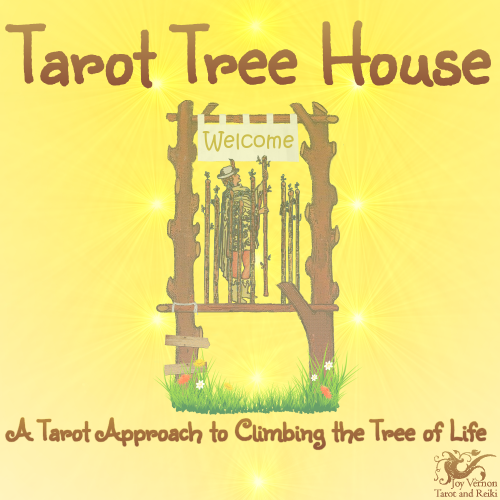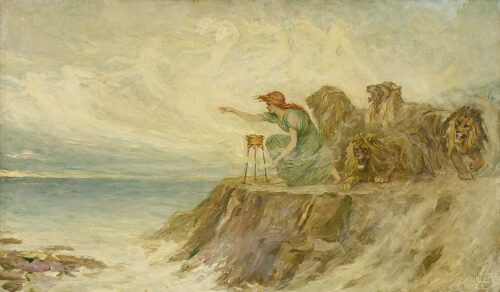The following article is part of the Tarot Tree House, an online class that teaches tarot and qabalah. If you’d like more info, and to pledge as my patron so you get additional materials like tarot spreads, meditations, and webinars, please visit me on Patreon.
The Path of Enlightenment and the Path of Redemption
I described the Tarot Tree House as a “tarot approach to climbing the Tree of Life.” The Tree of Life is often compared to a ladder and represents spiritual ascent. But as we can climb the Tree towards the Divine, so the Divine can reach down toward us. These two directions are called the Path of Redemption and the Path of Enlightenment.
The Path of Enlightenment is the descent of divine energy from above. This descent is expressed symbolically as the Lightning Flash Path, shown as a sword bent into the jagged path of a lightning strike. Each jag on the path marks the turn at one of the sephiroth. Each sephirah is touched in turn, from Kether at the top to Malkuth at the bottom. This is the path G-d takes when reaching out to us—it is the experience of enlightenment.
The Path of Redemption is the ascent of mundane energy from below. This is the Path of the Serpent and symbolically is represented by a snake that coils around each of the navitoth, the twenty-two paths on the tree that connect one sephirah to another. The serpent winds in and around each path, but does not touch the ten sephiroth. This is how we reach up to G-d, which we do by studying and working the paths of the Tree of Life.
The ten sephiroth represent levels of consciousness. Each represents a state of being or experience, all of which are naturally part of the human condition and necessary at times. The navitoth, or the paths that connect one sephirah to another, are the methods we use to transition from one level of consciousness to another.
In the study of qabalah, first it is necessary to become more deeply aware of each of the ten states of consciousness represented by the sephiroth and how they fit into our lives. By examining their relationship one to the other, and their position on the Tree and how they are placed on the pillars, we are able to put each sphere in a larger context and understand it less personally and more universally. By releasing the subjective and resting in the objective, we can simply observe how life around us manifests as different aspects of the Tree, and we are much less likely to get caught up in the illusory immediacy of a temporary imbalance.
After the ten sephiroth are understood, then we begin to learn the twenty-two paths. Each path is related to one of the twenty-two letters of the Hebrew alphabet and one of the twenty-two tarot trumps. The sephiroth are static, and primarily derive meaning from their correspondences. But the navitoth are more experiential and personal. They are best understood through meditation. A type of meditation rather like Jungian active imagination is used to travel the paths. This meditation is called pathworking and combines a variety of active and passive meditative techniques to engage the qualities of each path as fully as possible. The study of qabalah and the practice of pathworking help us to equilibrate within ourselves the variety of experiences we encounter in the external world of everyday life.
An aphorism states that when we reach up to G-d, G-d will come down to us. So by doing pathworking and striving to understand the Tree and ourselves better, we create an environment in which enlightenment, G-d reaching down toward us, becomes possible.

The symbols of the Lightning Flash Path and the Path of the Serpent sometimes appear in tarot cards. For instance, in the RWS Tower, we see a number of qabalistic symbols. Although the Tower’s path on the Tree connects two of the lower sephiroth, number 8 to number 7, much of its iconography pulls from the highest reaches of the Tree. The Lightning Flash, with the bent final jag imitating the shape of this path on the Tree, is seen knocking off the top of the tower, which appears as a crown, the title of the first sephirah, Kether. The gray structure features three flaming windows in a triangular pattern. The gray structure itself is reminiscent of the symbolism of Chokmah. The three windows call to mind the pattern of the three supernals, Kether, Chokmah, and Binah. There are twenty-two total yods, the spark of the Divine (we discussed this symbolism here), divided into two groups, one on either side of the Tower. To one side there are ten yods, the number of the sephiroth, to the other side are twelve yods, the number of the zodiacal signs. If you’ve ever heard the Tower card described as enlightenment, you can see why!
The blue gown over red shoes on the character on the right brings to mind Chesed, sephirah 4, Mercy, colored blue, while the red cloak over a blue garment on the left recalls Geburah, sephirah 5, Severity, colored red–the fact that each has an underlying color of the other reminds us that they are reciprocally linked. Overall, the symbolism of the card seems to indicate the breaking apart of divine unity into the contradictory poles of Mercy and Severity.
Meditating on the symbolism can help you understand the card better. This card reminds me of the experience of beginning a spiritual path. When we start to climb up the Tree (or begin any significant spiritual work), sometimes the sudden influx of spiritual energy causes an extreme disruption. G-d reaching down to us can be a terrifying experience and often seems to toss us completely off our path. The Tower is associated astrologically with the planet Mars, a symbol of Geburah, Severity (some artists make the lightning flash in the card look like the Mars symbol). In The Mystical Qabalah, Dion Fortune describes Chesed as anabolic, building up, and Geburah as catabolic, breaking down. The fours (Chesed) represent solidity, the fives (Geburah) represent time which ultimately destroys everything temporal. The destructive force of Mars on the lower level mirrors creation at the highest level. What is destroyed above is created below, and what is destroyed below is created above. When your attempt to pursue a spiritual path seems to leave destruction in its wake, ask if that destruction is at the temporal level or the spiritual level, and ponder what is being created on the other plane.
Now that we’ve explored the symbol of the Lightning Flash, look through your deck for cards that use serpent symbolism. I found three in the Major Arcana of the RWS deck, and many more in other decks, particularly Golden Dawn based decks. Does the symbolism of the serpent in these cards reflect the qabalistic Path of Redemption? If so, in what way? What is something new that you learn about the cards by contemplating this symbolism?
***
Keep up to date with all the Tarot Tree House posts by subscribing on Patreon and get perks like joining our private Facebook Group, tarot spreads, meditations, webinars, and patron-only bonuses. If you’re not ready to become a patron, please follow this blog by subscribing via email (find the spot to add your email address at the top right).
_________________________________________________
Joy Vernon is widely recognized by tarot professionals as an expert tarot teacher and respected community leader. With over twenty years’ experience teaching energetic and esoteric modalities, Joy brings expertise and practiced familiarity to her specialty of esoteric tarot, which layers astrological and qabalistic symbolism onto the traditional tarot structure. Under her leadership, the Denver Tarot Meetup has grown into the most active and one of the largest tarot-specific meetups in the world. Joy works as a reader and teacher at Isis Books. To learn more, please visit JoyVernon.com.
© 2016 by Joy Vernon. All rights reserved.









